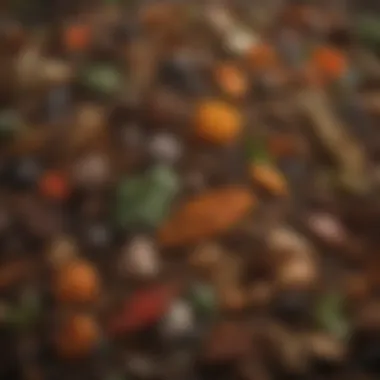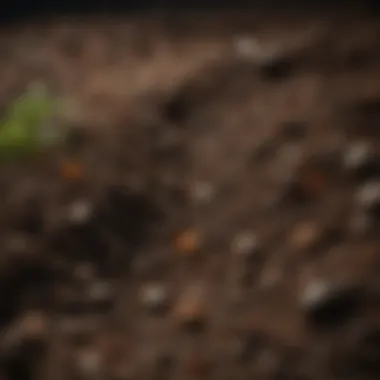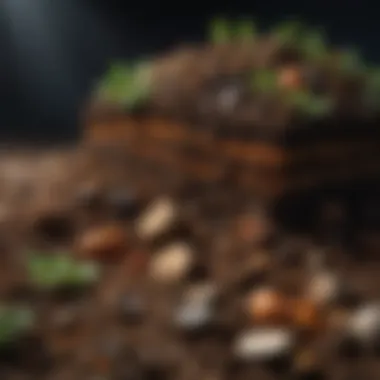Composting: Create Nutrient-Rich Soil Effectively


Intro
Composting serves as a pivotal practice for sustainable gardening. It converts organic waste into nutrient-rich soil amendments. Understanding composting is valuable for anyone interested in enhancing soil health and promoting sustainable methods of gardening. Soil plays an essential role in plant growth. Rich soil supports better plant development by improving nutrient availability and water retention. Thus, this guide aims to shed light on composting methodologies, essential materials, and practical approaches for achieving successful compost.
Importance of Composting
Composting not only reduces waste that ends up in landfills. It also enriches the soil by adding essential nutrients, improving soil structure, and stimulating beneficial organisms. Embracing composting promotes a healthier ecosystem.
Key Points to Discuss
In this guide, we will cover various aspects of composting. These include:
- The types of materials that can be composted
- Best practices for maintaining a compost pile
- Challenges faced during the composting process
- Optimal conditions for efficient composting
Understanding these points will help both novice and experienced gardeners to grasp composting techniques fully.
Understanding Composting
Composting serves as a cornerstone of sustainable gardening practices. Understanding the ins and outs of composting is crucial for anyone looking to enhance the health of their garden soil. The process allows organic materials to decompose naturally, turning waste into a valuable resource. It encourages a self-sustaining cycle that reduces landfill waste while providing essential nutrients to plants.
What is Compost?
Compost is a dark, crumbly substance created through the breakdown of organic materials. This includes kitchen scraps, yard waste, and other natural residues. The transformation occurs thanks to microorganisms, such as bacteria and fungi, which thrive in the right conditions. These organisms break down the organic matter over time, leading to a rich, nutrient-dense product that can greatly benefit soil.
Benefits of Composting
The advantages of composting are varied and significant. Here are some key benefits:
Enhancing Soil Structure
One important aspect of enhancing soil structure through composting is its ability to improve aeration and drainage. The presence of organic matter in the soil creates spaces that allow air and water to move more freely. This characteristic is vital for root development.
When gardener incorporate compost into their plots, they notice a marked improvement in soil texture. Loose, well-aerated soil fosters healthy root growth, and maintains moisture during dry spells. However, it is essential to balance the compost with existing soil types, as overly rich compost can lead to nutrient imbalance.
Improving Nutrient Availability
Improving nutrient availability is one of the compelling reasons for composting. The decomposition process enriches the soil with essential minerals, such as nitrogen, phosphorus, and potassium. These nutrients are critical for plant growth. Unlike synthetic fertilizers, compost offers a slow release of nutrients, which ensures that plants receive necessary sustenance over time.
Another aspect of this benefit is that compost helps in creating a stable environment for plants. It reduces the risk of nutrient leaching during heavy rains, providing a steady supply of nutrients. While the preparation of compost may seem time-consuming, the long-term benefits far outweigh the initial effort.
Supporting Microbial Life
Supporting microbial life is yet another vital benefit of composting. Healthy soil teems with microorganisms, which play a crucial role in nutrient cycling and disease suppression. Compost adds beneficial microbes to the soil, creating a balanced ecosystem that can enhance plant health.
The key feature here is diversity. The variety of microorganisms in compost helps to break down organic materials efficiently and promotes overall soil fertility. As a result, plants are better equipped to resist diseases and pests. Although slow initial decomposition can be seen as a disadvantage, patience in composting often results in a healthier growing environment.
By understanding the components and benefits of composting, homeowners can make informed decisions that enhance their gardens and the environment.
Essential Components of Compost
Understanding the essential components of compost is vital for anyone interested in creating nutritious soil efficiently. Composting is not merely a process but a science. The right balance of materials not only speeds up decomposition but also maximizes the vitamins and nutrients in the final product. Components can be broadly categorized into green materials, brown materials, and considerations for water and air.
Green Materials
Green materials are the nitrogen-rich elements of your compost. They provide the necessary nutrients that microorganisms require for growth and reproduction. Common sources include:
- Vegetable scraps
- Grass clippings
- Coffee grounds
- Fresh leaves
When incorporating green materials, be mindful of the ratios. A higher proportion of green materials can speed up the decomposition process. However, too much can lead to a soggy, smelly pile. It is best to mix these with brown materials, which brings us to our next point.


Brown Materials
Brown materials are carbon-rich components of compost. These include dry leaves, straw, cardboard, and wood chips. They play a crucial role in providing the necessary carbon for the composting process. The importance of brown materials cannot be understated. They help maintain structure in the compost pile, allowing for airflow. Proper airflow is essential for aerobic bacteria, which are responsible for breaking down organic matter. Here are several key considerations:
- Use dried materials to avoid excess moisture.
- Ensure variety in your brown materials to enhance nutrient diversity.
- Shredding can help increase surface area, facilitating quicker decomposition.
Water and Air in Composting
Water and air are two critical components often overlooked. While composting requires moisture, excessive water can lead to anaerobic conditions. This can produce foul odors and slow down the decomposition. Maintaining the right moisture balance is crucial. A well-balanced compost pile should feel like a damp sponge, not soaking wet.
Air circulation is equally important. Regular turning of the compost pile introduces oxygen, helps avoid compaction, and enhances microbial activity. Without sufficient air, composting can stall, resulting in a less efficient breakdown of materials.
To achieve optimal composting, balance green and brown materials while ensuring adequate moisture and airflow.
In summary, the essential components of compost are not merely a collection of organic waste. They are foundational elements that, when properly balanced, can create rich, fertile soil. Understanding the synergy between green materials, brown materials, and the role of water and air equips you with the knowledge to enhance your composting experience.
Setting Up Your Composting System
Setting up a composting system is the backbone of effective composting. The setup influences the entire process of decomposing waste into nutrient-rich soil. Properly organizing this phase allows for optimal airflow, moisture control, and effective breakdown of materials. Without a well-configured system, problems may arise that hinder the process and decrease the quality of compost. Hence, understanding how to establish a strong composting system is crucial for anyone interested in sustainable gardening.
Choosing the Right Location
The location of your composting system plays an essential role in its success. You want a spot that is convenient for adding materials and turning the pile. Look for a level area that allows for good drainage but isn’t prone to flooding. Ideally, this area should be near your garden. If it is too far away, you may find it cumbersome to transport materials regularly.
Additionally, the solution to maintaining temperature is crucial. A shaded area may prevent overheating while a sunny spot can speed up the decomposition. Observe how the sun hits the area during different seasons. This consideration significantly affects the speed of composting and the overall efficiency of your system.
Selecting a Compost Bin or Pile
The choice between a compost bin and a compost pile is often dictated by space, aesthetics, and ease of access. Each option has unique features that can cater to different needs.
Types of Compost Bins
Compost bins come in several forms, ranging from simple to complex designs. A key characteristic of compost bins is how they maintain the internal temperature and moisture levels. Some popular types include:
- Plastic Compost Bins: Affordable and lightweight, these bins are easy to move. They retain heat well but may not allow for sufficient airflow if not designed properly.
- Wooden Bins: Often more aesthetically pleasing and customizable, wooden bins can blend into garden surroundings. However, they may require more maintenance over time due to weather conditions.
- Tumbler Bins: These are a popular choice for those wanting convenience. They allow for easy turning without the manual labor of a traditional pile. The downside could be their cost and space requirement.
Each type facilitates specific advancements in achieving good composting practice. Make sure to consider where and how you want to use your compost bin in your garden to make the best selection.
DIY Compost Bins
DIY compost bins are an excellent solution for those who prefer to customize their composting system. They allow for creativity while being an economical choice. A key feature of DIY compost bins is their adaptability. You can build them with various materials like pallets, wire mesh, or old garbage cans. This approach enables an individual to create a bin suitable for their garden's specific needs.
The advantages of DIY compost bins include:
- Cost-Effectiveness: They utilize materials you may already have on hand.
- Customization: You can adjust size and design for your particular space constraints and garden needs.
- Flexibility: It’s possible to modify the design as your composting needs evolve.
However, there are disadvantages. For instance, they may not be as structurally sound as purchased bins, which could lead to leakage or collapse if not constructed properly.
Setting up the right composting system is foundational. Taking the time to make informed decisions about location and type of bin can enhance the efficiency of compost creation. Embrace the process, and the resultant nutrient-rich soil will greatly elevate your gardening efforts.
The Composting Process
The composting process is the heart of creating nutrient-rich soil. Understanding how composting works enables gardeners to optimize their efforts, ensuring effective decomposition and the production of high-quality compost. Each step in this process contributes to the overall success of composting. The decomposition of organic matter transforms waste into a resource that nourishes plants. Many factors within the composting process can influence how quickly and efficiently compost breaks down. As such, understanding these elements leads to a better composting experience.
Layering Materials
Layering materials is a key practice in composting. This method promotes aeration and moisture retention, which are vital for the decomposition process. By arranging materials into layers of green and brown materials, one can create an ideal environment for microorganisms. Green materials, such as kitchen scraps and grass clippings, provide nitrogen. On the other hand, brown materials like dried leaves and cardboard supply carbon. A balanced mix of these elements supports microbial activity, accelerating decomposition.
- Tip: Aim for a ratio of roughly one part green to three parts brown materials. This blend is crucial for optimizing the composting process.
Maintaining the Compost Pile


Turning the Compost
Turning the compost involves mixing the materials within the pile. This practice is important as it introduces air into the mix, which aids the aerobic bacteria responsible for breaking down the materials. Regular turning can speed up the composting process, often reducing the time it takes for materials to decompose significantly.
The key characteristic of turning the compost is that it promotes uniform decomposition. This ensures that all materials receive equal exposure to heat and moisture, allowing for effective breakdown. It is a popular choice among gardeners who aim for efficient composting.
However, turning the pile requires some effort and a basic understanding of when it is necessary. Generally, turning is recommended every few weeks. Overturning can disrupt the natural process and lead to nutrient loss.
Monitoring Moisture Levels
Monitoring moisture levels is essential to successful composting. Compost piles need a balanced moisture content—ideally, damp but not soggy. Keeping the right moisture level significantly influences the speed of the decomposition process. Microorganisms thrive in moist environments, and they require water to digest organic matter.
The primary characteristic of monitoring moisture is to ensure that the compost is not too dry or overly wet. Too much moisture leads to anaerobic conditions, causing odors and slowing down decomposition. Too little moisture can halt the process entirely.
A unique feature of moisture monitoring is that it involves both observation and testing. Gardeners often use their hands to gauge the moisture level—when squeezed, the compost should hold its shape but not drip water. This balance encourages a thriving ecosystem for bacteria and fungi.
Estimating Compost Timeline
Understanding the timeline for composting can help set realistic expectations. Various factors affect decomposition speed, including the size of materials, the balance between green and brown components, and environmental conditions. Generally, compost can take anywhere from two months to two years to mature.
- Fast Compost: Often results from smaller particle sizes and a well-balanced mixture, generally ready in about six weeks.
- Standard Compost: Takes about three to six months, depending on the conditions and materials used.
Monitoring changes in temperature within the pile can also provide insights. When the compost heats up, it indicates microbial activity. As temperatures drop, it signals the end of the active decomposition phase.
Estimating the compost timeline helps resource allocation and planning for garden applications. Knowing how long it can take for compost to mature will guide gardeners in providing the best growing conditions for their plants.
Troubleshooting Common Compost Problems
Composting is a rewarding practice, but it may also pose challenges. Knowing how to troubleshoot common compost problems is vital for maintaining a successful composting system. Being aware of these challenges allows you to create a thriving environment for decomposing organic materials. It enhances the overall process and minimizes frustrations. Understanding these issues and their solutions can help you reap the benefits of composting effectively.
Dealing with Odors
Odors can be a frequent issue in compost systems. Usually, unpleasant smells indicate an underlying problem. A common cause is a lack of adequate aeration or imbalanced materials. When compost is too wet or lacks sufficient brown materials, it can become anaerobic. This leads to sour, rotten smells. To mitigate this, consider the following actions:
- Turn the Compost: This increases oxygen supply, which helps the decomposition process.
- Add Brown Materials: Incorporate dried leaves or cardboard to balance the green materials.
- Maintain Moisture: Keep the compost pile moist, but not soggy, to support aerobic microbes.
Implementing these steps will not only minimize odors but also enhance the breakdown process in your compost bin.
Addressing Pests
Pests can become a concern in compost piles. Rodents, flies, and other critters may be attracted to your compost heap, especially if food scraps are improperly managed. To address this issue, consider the following strategies:
- Cover Food Waste: Always bury food scraps within the pile to reduce odors and deter pests.
- Use Secure Bins: Invest in compost bins with secure lids to prevent animal access.
- Monitor the Pile: Regular checks can help identify and manage pest issues early.
By taking these measures, you can minimize the risk of pest infestations in your compost system.
Identifying Slow Decomposition
Slow decomposition is a common problem many gardeners face. It can stem from several factors, such as inadequate moisture, improper materials, or lack of nitrogen. Identifying the cause is essential for addressing it. Here are some indicators and solutions:
- Check Moisture Levels: If the pile feels too dry, add water gradually – striking a balance is key.
- Assess Material Variety: Ensure a mix of green and brown materials for an effective carbon-to-nitrogen ratio.
- Increase Surface Area: Chopping or shredding larger materials can speed up decomposition.
Recognizing these symptoms can help caregivers ensure their compost decomposes efficiently.
Maintaining a healthy compost pile results in rich, nutrient-dense soil while reducing waste effectively. By troubleshooting common issues, you can optimize your composting efforts.
Using Finished Compost
Using finished compost is a crucial step in the gardening process. This organic material enhances soil quality and encourages plant growth. Understanding its application not only provides insight into sustainable gardening but also showcases the benefits of composting as an effective practice.


Assessing Compost Quality
Assessing compost quality is essential before introducing it to your garden. Factors include color, smell, and texture. Good compost typically appears dark brown, resembling rich soil. It should also have an earthy smell, indicating proper decomposition. If the compost has a foul odor, it might be under-processed or contain too many green materials.
Additionally, the texture should be crumbly rather than sticky. This indicates sufficient aeration and proper structure, essential for soil amendment. Perform a simple test by squeezing a handful of compost; if it retains its shape without excessive moisture, it is ready for use.
Application Methods for Gardens
Using finished compost effectively involves understanding the different application methods available. Two primary methods are top dressing and mixing into soil.
Top Dressing
Top dressing involves spreading a layer of compost on the soil surface around plants. This method provides numerous benefits. It enhances soil fertility gradually while helping to suppress weeds. A key characteristic of top dressing is ease of application; it requires no digging or disturbance of plant roots. As the compost breaks down, nutrients are released slowly into the soil.
This method is especially beneficial for established plants needing a nutrient boost. However, over-application can lead to a buildup of nutrients that may be harmful in certain circumstances. Thus, following recommendations on the application amount is prudent.
Mixing into Soil
Mixing finished compost into the soil is another effective method. It works well for new garden beds or when preparing soil for planting. A key characteristic of this technique is soil enrichment. By integrating compost, you improve water retention, aeration, and overall soil structure.
The unique feature of mixing into soil is that it creates a uniform nutrient profile throughout the planting area. While this method is beneficial, it does require extra effort compared to top dressing, including turning the soil to achieve even distribution. Additionally, it can disturb existing plants if not done carefully. Therefore, timing and technique are essential when choosing this method.
"Using finished compost properly maximizes benefits for your garden, ensuring plants thrive with rich, organic nutrients."
Maintaining Sustainable Composting Practices
Maintaining sustainable composting practices is essential for several reasons. Composting not only reduces waste but also enhances soil health and promotes ecological balance. Implementing effective composting techniques can significantly contribute to environmental sustainability, which is particularly important in today’s context of climate change and resource depletion. By adopting practices that minimize negative impacts and maximize benefits, individuals and communities can foster a healthier ecosystem.
Composting for Urban Dwellers
For urban dwellers, composting presents unique challenges and opportunities. Space is often limited, and residents may lack access to traditional composting setups. However, urban environments can benefit greatly from composting. With the right approach, anyone can establish a composting routine.
- Selecting Suitable Containers: Urban dwellers can utilize compact compost bins. Various designs are available on the market, or one might create a simple DIY bin using a plastic container or wooden crate. It’s important to ensure that these bins provide adequate aeration.
- Encouraging Community Involvement: Engaging with neighbors can amplify efforts. Setting up a community composting site or joining a local composting co-op allows for better waste management and the sharing of resources. This way, participants can pool materials and compost together, fostering a sense of community.
- Dealing with Limited Space: For those who live in apartments, vermicomposting can be a practical solution. By keeping a small bin of worms, individuals can convert kitchen scraps into compost without needing much space.
Incorporating Composting into Daily Life
Incorporating composting into daily life can be straightforward yet rewarding. Establishing habits around composting can significantly influence household waste management positively.
- Setting Up a Kitchen Bin: Keep an attractive, accessible container in the kitchen for collecting scraps. This can be a small bucket or even a decorative bowl. Regularly add vegetable peelings, coffee grounds, and eggshells.
- Creating a Schedule: Dedicate specific days for transferring compostable materials from the kitchen bin to the main composting area. This way, the process remains organized, and there will be less risk of odors or pests.
- Educational Initiatives: Educating family members about which materials are compostable and the importance of reducing waste can instill lasting composting habits. This knowledge not only benefits the composting process but also enhances overall environmental awareness.
"Composting is not just a method of waste disposal; it’s a way to nourish the earth and close the loop on our consumption."
Maintaining sustainable composting practices is vital for urban dwellers and homeowners alike. By focusing on practical strategies, we can contribute to a greener future. This approach not only benefits the environment but also enhances personal gardening efforts, creating a cycle of sustainability.
Epilogue
Composting holds significant importance in gardening and environmental sustainability. This concluding section emphasizes the benefits of maintaining a composting practice, highlights key takeaways from the guide, and reiterates the role composting plays in healthily enriching soil.
Reiterating the Importance of Composting
Composting is not merely a passing trend but an essential approach for homeowners and gardening enthusiasts alike. It aids in transforming kitchen waste and yard debris into a valuable resource for plant growth. By doing this, one contributes to reducing waste sent to landfills, thus fostering a more sustainable environment.
Environmental Benefits
The process of composting helps to lessen the carbon footprint of households. Instead of throwing organic waste in the trash, composting turns this waste into usable compost which releases nutrients back into the soil. This leads to healthier, more resilient plants. Furthermore, it reduces the need for chemical fertilizers that can harm the ecosystem.
Soil Health Improvement
Compost introduces vital microorganisms into the soil, enhancing its fertility. This improvement boosts soil aeration, structure, and moisture retention. Such enhancements are particularly crucial for urban dwellers who often face challenges with poor soil quality.
Economic Advantages
Homemade compost can lead to significant savings. Instead of purchasing fertilizers or soil amendments, gardeners can create their own. This not only reduces expenditure but also minimizes reliance on store-bought products, which often carry environmental costs in their production and transportation.
"The act of composting is both an ecological responsibility and a practical solution for improving soil health."
Incorporating composting practices into daily life is an achievable goal for anyone, whether seasoned gardeners or novice apartment dwellers. The knowledge acquired from this guide equips individuals to overcome initial hesitations and engage in sustainable gardening practices.
By understanding the importance of composting, one becomes more aware of their impact on the environment and can contribute to greener practices within their community. As one embarks on this journey towards effective composting, they not only enhance their gardening endeavors but also participate in a global movement towards sustainability.



